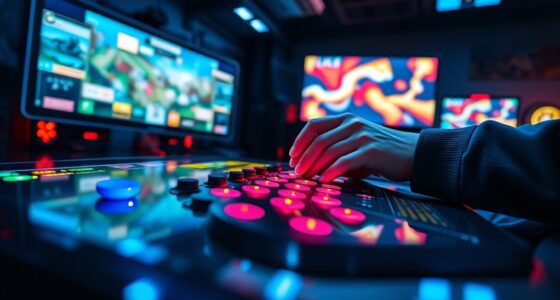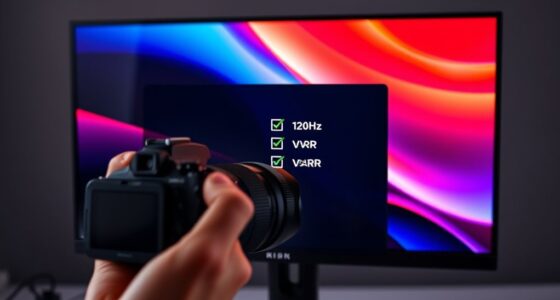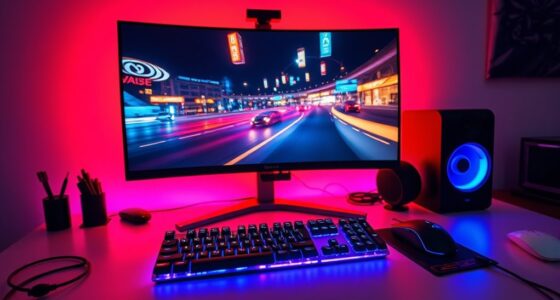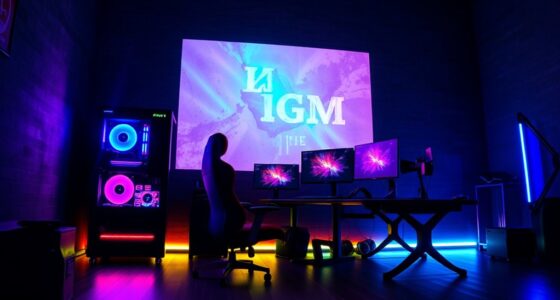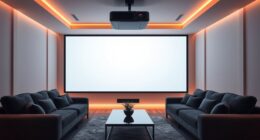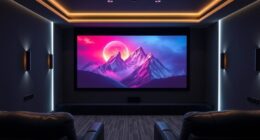Using a projector for PC gaming gives you a huge, immersive screen that makes games more exciting and easier on your eyes. You’ll want to pick the right projector—short-throw for smaller spaces or laser models for brighter images—and connect it smoothly to your PC with the right cables. Adjust the settings for sharp visuals and sound, and control your environment for the best experience. Keep everything maintained, and you’ll enjoy seamless, cinematic gaming — learn more to maximize your setup.
Key Takeaways
- Using a projector for PC gaming creates a large, immersive screen that enhances gameplay experience.
- Choose the right projector type (short-throw or long-throw) based on your room size and setup needs.
- Proper placement, environment control, and calibration are essential for clear, sharp image quality.
- Connect external speakers or sound systems to ensure immersive, high-quality audio during gaming sessions.
- Regular maintenance and optimal setup help prevent lag, improve image clarity, and ensure a seamless gaming experience.
Why Use a Projector for Gaming?

Using a projector for gaming can considerably enhance your experience by creating a larger, more immersive screen. Many projection myths suggest that projectors aren’t suitable for gaming due to lag or poor image quality, but modern models have minimized these issues. In fact, they can provide stunning visuals that a traditional monitor can’t match. Plus, gaming ergonomics improve when you have a spacious setup, reducing eye strain and allowing you to enjoy longer gaming sessions comfortably. A projector’s big display encourages a more natural viewing angle, helping you stay engaged without neck strain. With the right setup, a projector can transform your gaming space into an epic battlefield or vast open world, making every session more exciting and immersive. Additionally, high refresh rates in some projectors further enhance smooth gameplay, making fast-paced action more responsive and enjoyable.
Types of Projectors Suitable for Gaming

When choosing a projector for gaming, you’ll need to contemplate whether a lamp or laser model best fits your setup. Short-throw projectors can save space and provide a larger image from a smaller distance, while long-throw options are better for bigger rooms. Understanding these differences helps you select the perfect projector for your gaming environment.
Lamp vs. Laser Models
While both lamp and laser projectors can deliver impressive visuals for gaming, laser models are increasingly favored for their brightness, longevity, and consistent performance. When comparing lamp vs. laser, projector brightness is a key factor. Laser projectors typically offer higher brightness levels, making them ideal for rooms with ambient light or larger screens. They also maintain brightness longer over time, reducing the need for frequent replacements. In contrast, lamp projectors may initially be cheaper but tend to lose brightness as the lamp ages, impacting your gaming experience. Laser models provide steadier performance with minimal maintenance, ensuring you enjoy vibrant, sharp images without interruptions. If you’re serious about gaming quality and durability, laser projectors are the smarter choice. Additionally, laser projectors often incorporate advanced cooling systems, which help extend their lifespan and maintain consistent image quality during long gaming sessions.
Short vs. Long Throw
Choosing the right projector for gaming depends largely on your available space and setup preferences. Short throw projectors have a low throw ratio, meaning they can produce a large image from a short distance, making them ideal for small rooms. Long throw projectors, with higher throw ratios, require more space but can project larger images from farther away. Understanding projector lens types helps determine which is best; short throw lenses minimize shadows and glare, while long throw lenses suit larger spaces. The main throw ratio differences dictate how much space you need to set up comfortably. If you have limited room, a short throw projector allows for a big screen without crowding your gaming area. Conversely, long throw models are suited for dedicated home theaters with ample space. Knowing about projector placement can help optimize your setup for the best gaming experience.
Understanding Resolution and Screen Size

Understanding resolution and screen size is essential for optimizing your gaming experience with projectors. Higher resolution provides better resolution clarity, making game details sharper and more immersive. Screen size impacts how large your image appears and how much you see at once. Larger screens may require higher resolution to prevent pixelation. Keep in mind that the right balance between resolution and screen dimensions enhances your gameplay without sacrificing image quality. Achieving the right visual balance is key to a satisfying gaming setup.
Connecting Your PC to a Projector

To connect your PC to a projector, you need to choose the right cable that matches both devices’ ports. Once connected, you’ll want to adjust your display settings to optimize the image quality and size. Properly configuring these settings guarantees you get the best gaming experience on the big screen. For additional enhancement, consider exploring best anime movies to enjoy themed content during your gaming sessions.
Choosing the Right Cable
Connecting your PC to a projector requires selecting the right cable to guarantee a smooth setup. Your choice depends on the cable types and connection standards your devices support. For high-definition gaming, you’ll want a cable that can handle the necessary resolution and refresh rates. Common options include HDMI, DisplayPort, and VGA. HDMI and DisplayPort are modern, supporting digital signals and higher quality, while VGA is older and analog. Consider your PC and projector’s ports before buying. Verify the cable length is sufficient for your setup, but not so long that it causes signal degradation. Using the right cable type and connection standards assures a clear, lag-free gaming experience. Additionally, understanding your time zone differences can help you coordinate gaming sessions with friends across the globe.
Configuring Display Settings
After securing the right cable, the next step is to configure your display settings to guarantee your PC and projector work seamlessly together. Begin by adjusting your resolution and refresh rate to match your projector’s specifications for ideal image quality. Next, perform color calibration to ensure accurate colors and brightness levels, which is especially important for gaming clarity. Consider your ambient lighting environment; dim or control lighting to reduce glare and improve contrast, making your gaming experience more immersive. Use your operating system’s display settings or dedicated calibration tools to fine-tune brightness, contrast, and color balance. Properly configuring these settings helps prevent eye strain and guarantees vibrant visuals, giving you the best possible gaming experience on your projector.
Adjusting Image Quality and Settings

Adjusting image quality and settings is essential for getting the best gaming experience with your projector. Proper tweaks ensure vivid colors, sharp details, and smooth gameplay. Start with color calibration to match your display to your room’s lighting, making images more natural. Adjust image sharpening to enhance detail without introducing noise or halos. Fine-tuning contrast and brightness levels helps achieve ideal picture depth. Consider turning off unnecessary image processing features that can cause lag. Also, tweak gamma settings to improve visibility in dark scenes. Here are key points to focus on:
- Perform color calibration for accurate hues
- Adjust image sharpening for crisp visuals
- Set contrast and brightness for depth
- Turn off post-processing effects that cause lag
- Tweak gamma for better dark scene detail
Additionally, understanding how visual perception affects image quality can help you make more informed adjustments for a truly immersive gaming experience.
Choosing the Right Placement and Environment

Choosing the right placement and environment is essential for maximizing your projector’s performance and ensuring an immersive gaming experience. Start by selecting a wall placement that provides a large, flat surface free of obstructions. A smooth, light-colored wall or a dedicated projection screen works best for sharp images. Avoid placing the projector too close or too far from the wall to achieve ideal focus and size. Pay attention to ambient lighting—bright lights and sunlight can wash out the image, so dim the room or use blackout curtains. Minimize reflections and glare by controlling ambient light sources. Creating a dark, controlled environment will enhance contrast and color accuracy, giving you a more vivid and engaging gaming experience. Additionally, understanding how market volatility affects precious metals can help you optimize your investment environment for better stability and returns.
Managing Sound When Using a Projector

To get great sound for your gaming setup, consider setting up external speakers instead of relying on your projector’s built-in audio. Connecting your sound system properly guarantees clear, immersive audio without lag or distortion. Make sure your projector and speakers are compatible and correctly linked for the best experience. Using quality audio equipment can also help prevent audio issues like lag or distortion, ensuring a seamless gaming experience.
External Speakers Setup
Managing sound when using a projector often requires external speakers, as built-in projector audio is typically inadequate for an immersive gaming experience. To set up external speakers effectively, start with audio calibration to ensure sound levels match your gaming environment. Wireless speakers are a popular choice, offering flexibility and easy placement without messy cables. Position your speakers for ideal sound coverage, ideally at ear level and facing your seating area. Use a quality audio cable or wireless connection to link your speakers to your PC or AV receiver. Test the setup by playing in-game sounds to verify clarity and volume. Adjust settings for balance, avoiding distortion or echo. Proper calibration and speaker placement guarantee you get the most immersive sound from your projector gaming setup.
Sound System Connectivity
Since your projector may not have reliable built-in audio, connecting your sound system properly is essential for an immersive gaming experience. Wireless audio options, such as Bluetooth speakers or soundbars, simplify setup and reduce cable clutter. If you want surround sound, consider a dedicated home theater receiver that connects to your projector via HDMI ARC or optical cable. This setup allows you to enjoy multi-channel audio that enhances gameplay depth. You can also use wireless surround sound systems that transmit audio without wires, keeping your space tidy. Verify your sound system is compatible with your projector’s outputs. Properly managing your audio connections guarantees clear sound, immersive surround sound, and an overall better gaming experience.
Benefits and Drawbacks of Projector Gaming

Projector gaming offers an immersive experience that can transform your gaming setup, but it also comes with certain challenges. One major benefit is the large display size, creating a more cinematic feel. However, drawbacks include the need for high projector brightness to combat ambient light and ensure vibrant visuals. Gaming latency is another concern, as some projectors may introduce delays that affect responsiveness. Additionally, image quality can vary depending on the projector’s resolution and contrast ratio. Setup complexity and space requirements can also be hurdles, especially in smaller rooms. On the plus side, projectors often cost less than large-screen TVs and can be easily stored away when not in use. Overall, weighing these benefits and drawbacks helps you decide if projector gaming suits your style.
Tips for a Smooth Gaming Experience

To enjoy a seamless gaming experience with your projector, paying attention to a few key setup tips can make all the difference. First, optimize your projection angles to ensure the image is square and clear, avoiding distortion. Adjust the height and tilt of your projector to prevent keystone effects and ensure a consistent picture. Additionally, control ambient lighting; dimming or turning off lights minimizes glare and enhances contrast, making the visuals more vibrant. Use blackout curtains or position your projector away from windows to reduce unwanted light interference. Keep your projector at a proper distance for the desired screen size, and ensure it’s stable to prevent image shifts. These small adjustments can considerably improve your gaming clarity and overall experience.
Maintaining and Caring for Your Projector

Regular maintenance is essential to keep your projector functioning at its best. Proper projector maintenance ensures clear images and a longer lifespan. To start, regularly clean the projector lenses to prevent dust buildup that can distort your picture. Keep the vents free of dust to prevent overheating. Use a soft, lint-free cloth for cleaning, avoiding harsh chemicals. Schedule periodic filter replacements if your projector has filters. Handle the device carefully, avoiding impacts. Store your projector in a cool, dry place when not in use. Additionally, check for firmware updates to optimize performance.
Regular projector maintenance boosts picture clarity and extends device lifespan.
- Clean the projector lenses gently with a microfiber cloth
- Dust off vents and filters regularly
- Avoid touching the lens with your fingers
- Use a can of compressed air to clear dust from internal parts
- Keep the projector in a safe, stable environment
Frequently Asked Questions
Can Projectors Handle Fast-Paced or Competitive Gaming?
Yes, projectors can handle fast-paced or competitive gaming if they have a high refresh rate and low input lag. Look for projectors with at least 60Hz refresh rate and input lag below 20ms to guarantee smooth visuals and quick response times. Keep in mind, some projectors may struggle with motion clarity, so choosing one designed for gaming helps you stay competitive without motion blur or delays.
What Is the Typical Lifespan of a Gaming Projector Bulb?
A gaming projector bulb typically lasts between 1,500 to 3,000 hours, depending on usage and bulb quality. You’ll notice bulb durability varies, and frequent gaming can shorten its lifespan. Replacement costs can range from $200 to $500, so it’s smart to contemplate this when choosing a projector. Regular maintenance and proper ventilation can help extend the bulb’s life, saving you money and ensuring smooth gaming sessions.
Are There Specific Projector Brands Best for Gaming?
If you’re looking for a reliable gaming projector, brands like BenQ stand out. For example, a gamer I know chose a BenQ projector with 4K resolution, enhancing visuals and immersion. While gaming projector cost varies, BenQ offers options balancing affordability and quality. Look for projectors with high resolution and low input lag to guarantee smooth gameplay. Ultimately, choose a brand known for durability and excellent image quality to elevate your gaming experience.
How Does Ambient Light Affect Projector Gaming Experience?
Ambient light can substantially impact your projector gaming experience by causing screen glare and reducing image clarity. When there’s too much light, your game visuals become washed out, making it harder to see details and enjoy immersive gameplay. To improve your experience, try to control ambient light by dimming lights or using blackout curtains. This helps maintain vibrant colors and sharp images, ensuring you get the most out of your gaming sessions.
Is a Gaming Projector More Energy-Efficient Than a Monitor?
A gaming projector generally uses more energy than a monitor, mainly due to their larger light sources and higher brightness levels, which increase energy consumption. This means they can have a bigger environmental impact over time. If you’re aiming for efficiency, a monitor usually consumes less power and is more environmentally friendly. However, projectors offer a bigger screen experience, so weigh your priorities when choosing between them.
Conclusion
Think of your projector as the gateway to an epic adventure, turning your room into a vast battlefield or a sprawling landscape. With the right setup and care, your gaming experience becomes a smooth, immersive journey—like sailing on calm waters. Keep your equipment well-maintained, adjust settings wisely, and embrace the thrill of the game. Soon, every session feels like stepping into a new world, where your imagination leads the way.


